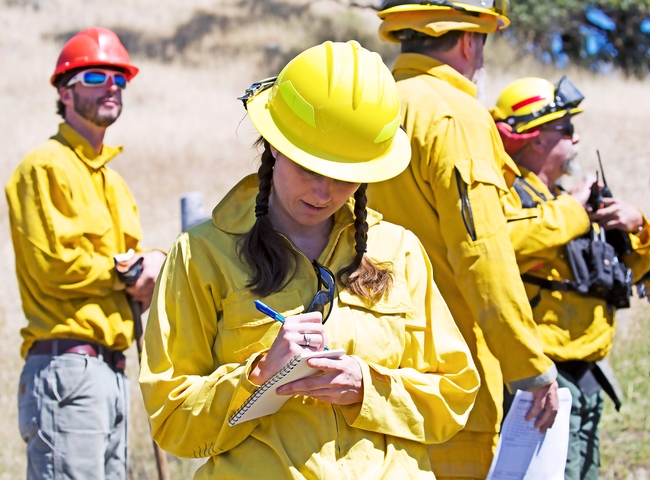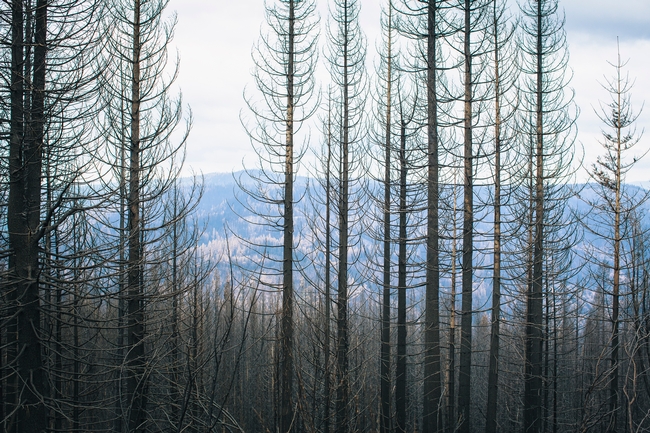Posts Tagged: resilience
UCCE seeks statewide input to develop future wildfire programs
University of California Cooperative Extension has recently expanded their team of fire advisors and staff. This new group of UCCE fire professionals is interested in learning about the concerns of the communities that UCCE serves, as well as the natural resource professionals already working to address these issues.
Results from this survey will enhance the team's ability to partner with residents, landowners, agencies, academics, and other organizations to reduce California's vulnerability to wildfires. These new advisors will also share survey results with UCCE colleagues throughout the state, who already provide important fire-related programming across diverse landscapes and audiences.
"Wildfires will continue to affect all Californians, either directly or indirectly," said Katie Low, UCCE statewide fire coordinator. "It's invaluable to have the input of as many people as possible to guide the development of our wildfire-related extension programs, so that they can provide the most useful resources and information to communities across California."
The survey asks questions about topics such as:
- Gaps within existing educational programming and resources
- Challenges community members are facing in addressing wildfire risk
- Empowerment of communities to make property management decisions and prepare for wildfire
- Acceptability of prescribed fire and other fuels treatments
By participating in this study, you can choose to enter a drawing to win one of fifty $20 VISA gift cards.
To take the online survey, please visit https://bit.ly/UCCE_Fire_Survey.
This research is being led by a team of new UCCE fire advisors and staff. If you have any questions about this survey, please contact the fire/forestry professionals involved in this survey effort:
- Luca Carmignani, UCCE fire advisor for Los Angeles, Orange, Riverside, and San Diego counties, carmignani@ucanr.edu
- Alison Deak, UCCE fire advisor for Fresno, Madera, and Mariposa counties, aldeak@ucanr.edu
- Katie Low, UCCE fire academic coordinator for Nevada and Placer counties, katlow@ucanr.edu
- Barb Satink Wolfson, UCCE fire advisor for Monterey, San Benito, Santa Clara, and Santa Cruz counties, bsatinkwolfson@ucanr.edu
- Ryan Tompkins, UCCE forestry advisor for Plumas, Sierra, and Lassen counties, retompkins@ucanr.edu
For more information about wildfire-related programming from University of California Cooperative Extension, please visit https://ucanr.edu/sites/fire/ or the Facebook page https://bit.ly/fireSolutions.
Just what is a ‘resilient’ forest, anyway?
Study finds resilient, frequent-fire forests have far fewer trees
What does a “resilient” forest look like in California's Sierra Nevada? A lot fewer trees than we're used to, according to a study of frequent-fire forests from the University of California, Davis.
More than a century ago, Sierra Nevada forests faced almost no competition from neighboring trees for resources. The tree densities of the late 1800s would astonish most Californians today. Because of fire suppression, trees in current forests live alongside six to seven times as many trees as their ancestors did — competing for less water amid drier and hotter conditions.
The study, published in the journal Forest Ecology and Management, suggests that low-density stands that largely eliminate tree competition are key to creating forests resilient to the multiple stressors of severe wildfire, drought, bark beetles and climate change.
This approach would be a significant departure from current management strategies, which use competition among trees to direct forest development.
Defining ‘resilience'
But first, the study asks: Just what does “resilience” even mean? Increasingly appearing in management plans, the term has been vague and difficult to quantify. The authors developed this working definition: “Resilience is a measure of the forest's adaptability to a range of stresses and reflects the functional integrity of the ecosystem.”
They also found that a common forestry tool — the Stand Density Index, or SDI — is effective for assessing a forest's resilience.
“Resilient forests respond to a range of stressors, not just one,” said lead author Malcolm North, an affiliate professor of forest ecology with the UC Davis Department of Plant Sciences and a research ecologist with the U.S. Forest Service, Pacific Southwest Research Station. “‘Resistance' is about surviving a particular stress, like fire — but there's a lot more going on in these forests, particularly with the strain of climate change.”
Competitive nature
For fire-adapted forests in the Sierra, managing for resilience requires drastically reducing densities — as much as 80% of trees, in some cases.
“Treatments for restoring resilience in today's forests will need to be much more intensive then the current focus on fuels reduction,” said Scott Stephens of UC Berkeley, a co-author on the paper.
The study compared large-scale historical and contemporary datasets and forest conditions in the southern and central Sierra Nevada, from Sequoia National Forest to the Stanislaus National Forest. It found that between 1911 and 2011, tree densities increased six- to seven-fold while average tree size was reduced by half.
A century ago, both stand densities and competition were low. More than three-quarters of forest stands had low or no competition to slow a tree's growth and reduce its vigor. In contrast, nearly all — 82%-95% — of modern frequent-fire forests are considered in “full competition.”
The study indicates that forests with very low tree densities can be more resilient to compounded threats of fire, drought and other climate stressors while maintaining healthy water quality, wildlife habitat and other natural benefits. Forests burned by high-severity fires or killed by drought lose such ecosystem services.
Wake-up call
The authors say the 2012-2016 drought, in which nearly 150 million trees died from drought-induced bark beetle infestations, served as a wake-up call to the forestry community that different approaches are required to help forests confront multiple threats, not only severe wildfires.
A shift away from managing for competitive forests and toward eliminating competition could allow the few to thrive and be more resilient.
“People have grown accustomed to the high-density forest we live in,” North said. “Most people would be surprised to see what these forests once looked like when frequent surface fires kept them at very low densities. But taking out smaller trees and leaving trees able to get through fire and drought leaves a pretty impressive forest. It does mean creating very open conditions with little inter-tree competition. But there's a lot of historical data that supports this.”
“We think resilient forests can be created, but it requires drastically reducing tree density until there's little to no competition,” said Brandon Collins of UC Berkeley, another co-author on the paper. “Doing this will allow these forests to adapt to future climate.”
Additional co-authors include Ryan Tompkins of UC Cooperative Extension, and Alexis Bernal and Robert York of UC Berkeley.
The study was funded by the National Park Service Pacific West Region, U.S. Forest Service Pacific Southwest Research Station, U.S. Joint Fire Sciences Program, and the UC Agriculture and Natural Resources Division.



